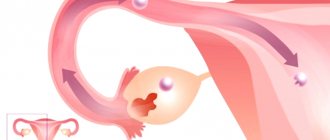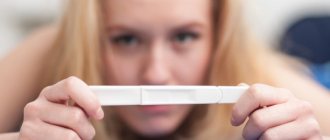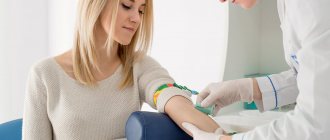On what day does ovulation occur after menstruation?
Not in all cases, egg maturation is carried out strictly in accordance with normal parameters. To understand how long after menstruation ovulation occurs, it is enough to familiarize yourself with the peculiarities of the functioning of the female reproductive organs. The enlargement of the follicles in which oocytes are formed is carried out under the influence of estrogens. If they are produced in the required quantity, the follicle grows by 1-2 mm per day. The release of the egg occurs a few days after the follicle becomes mature. By this time it should reach 18-25 mm. If estrogens are produced more actively than usual, the follicles mature earlier. The following factors contribute to this:
- Stressful situations;
- Hormonal disorders;
- Hereditary diseases;
- Metabolic disease;
- Infectious and inflammatory problems.
Stages of egg development
Spontaneous ovulation after menstruation is not uncommon. In gynecology it is considered a pathology. It provokes a change in the cyclicity of physiological processes and is an obstacle to the successful fertilization of the oocyte. The fertilized egg will not be able to penetrate the upper layers of the uterine cavity, as it will not have time to reach the required volume and structure.
How many days after menstruation does ovulation occur?
The functioning of the organs responsible for reproduction is regulated by hormonal levels. If it is normal, then the development of the oocyte occurs according to a given algorithm. It is important for anyone who wants to have offspring to know what day after menstruation ovulation occurs. This information will help you prepare for motherhood. The average length of the cycle reaches 4 weeks. In this situation, the ovulatory period occurs on the 14-15th day of the cycle. If the cycle lasts longer than usual, then the oocyte will become ready to merge with sperm later.
If the egg does not come out
In some cases, ovulation does not occur at all during the cycle, then they speak of anovulation. Even in the healthiest patients, cells are not able to mature in every cycle; approximately a couple of cycles remain without ovulation, which is quite normal. Gradually, there are more and more such cycles as the body ages and follicular reserves are depleted. By the age of 35, almost every second or third cycle is anovulatory. In addition to physiological reasons, this condition can also be provoked by a variety of psycho-emotional experiences, stress, inflammatory pathologies of the genital organs and genitourinary system, dysfunctional disorders of the activity of intraorganic structures, etc.
https://youtu.be/oqgyH8AOxyM
So, calculating the ovulatory period is not at all difficult, even on your own. If traditional home methods like basal charts or ovulatory pharmacy tests do not produce results, then you need to contact specialists who, if necessary, will conduct ultrasound monitoring.
When does the egg mature in the ovaries after menstruation?
Ovulyaciya.com
The duration of menstruation varies in each individual case. On average, menstruation lasts 3-6 days. During this period, the endometrium, which has grown over the previous cycle, is rejected. Menstruation is accompanied by unpleasant sensations in the stomach and poor health. The growth of oocytes is stimulated by sex hormones, which begin to be actively produced immediately after the completion of the menstrual cycle. Therefore, the follicle ruptures approximately 7-9 days after the end of bleeding. In situations where ovulation occurs immediately after menstruation, there is no question of the proper functioning of the reproductive system. Pathology indicates hormonal disorders in the body.
When does ovulation occur after menstruation?
The determining factor when calculating fertile days is the duration of the cycle. While the length of the follicular phase can vary, the luteal phase is always the same. It lasts 2 weeks and begins immediately after the release of the egg. On what day does ovulation begin after menstruation can be determined with the greatest accuracy by women who have regular menstruation. Their oocyte release most often occurs on the same day of the cycle.
Calculation of the menstrual cycle
In other cases, by counting it is possible to obtain only an approximate result. To do this, subtract 14 days from the average cycle length. The resulting number indicates on what day the female body becomes ready to conceive. To predict the average length of the cycle, it is necessary to record menstrual data for 3 months. To do this, you should keep a special calendar. Based on the information received, average indicators are identified.
How to calculate the days for conceiving a child using a calendar method
How to count the day of ovulation to get pregnant? The most accessible and uncomplicated method is the calendar method. At the same time, it requires patience and organization, because you will have to track your menstrual cycle for at least 6 months. The correct determination of the moment of egg release ultimately depends on the accuracy of the calculations. To do this, you need to note the days of your period and their duration.
This calculation method is based on the fact that ovulation occurs 14 days before the end of the cycle. By noting the days when menstruation arrives over a period of 5-6 months, using regular calculations, it will be possible to determine the estimated period for the release of the egg. To do this, count 14 days in each of the longest and shortest cycles and obtain a favorable interval for conception. As an example, we bring to your attention the following application of the calendar method.
- The best remedy for nail fungus
- Celandine for toenail fungus
- How not to start smoking again
Duration:
- 1 month 26 days
- 2 months 28 days
- 3 months 26 days
- 4 months 29 days
- 5 months 27 days
- 6 month 30 days.
Calculation:
- 30-14=16 – the release of the egg in the longest cycle occurred on the 16th day.
- 26-14=12 – in the shortest by 12.
In this regard, the onset of ovulation is possible in the period from 12 to 16 days of the cycle. However, it is worth noting that experts note only 30% reliability of this method. For this reason, using the calendar method to protect against unwanted pregnancy is not recommended.
When does the egg mature in the ovaries after menstruation for fertilization?
All processes in a woman’s body occur in a clear sequence. Ovulation without menstruation is impossible. If the process of fusion of the female cell with the sperm does not occur, menstruation will begin 2 weeks after it enters the peritoneal cavity. It becomes mature while in the follicular membrane. But she is able to encounter a sperm only within 24-48 hours after its rupture.
The process of fusion of the egg with the male seed occurs in the fallopian tubes.
When does ovulation occur after menstruation? Some women claim that pregnancy in their case was triggered by ovulation before menstruation. This statement can be considered true. In gynecology there is a term “late ovulation”. The deviation is accompanied by slow maturation of the egg. For this reason, the first phase of the cycle is delayed. This provokes problems with the regularity of the cycle. On the days when a woman begins to prepare for her period, she ovulates. With an increase in estrogen, ovulation occurs after menstruation. Unlike late ovulation, it cannot lead to a full pregnancy due to the unprepared endometrium. Early rupture of the follicle can also provoke:
- Lifting weights;
- Taking sage decoction;
- Hormonal drugs;
- Abdominal exercises;
- Hot bath.
Sage
Early ovulation occurs on days 5-10 of the cycle. The earlier it occurs, the lower the likelihood of pregnancy. If the follicular membrane ruptures on days 11-12 of the cycle, fertility increases.
Maturation of the egg after menstruation by day
To determine how many days after menstruation ovulation occurs, it takes a long time to observe the body. Each stage of egg growth is accompanied by certain signs. A few days after the end of menstruation, characteristic tingling sensations appear in the appendages. As the follicles grow, the pain may intensify. Closer to ovulation, the following symptoms are observed:
- Mucous discharge from the vagina;
- Increased sex drive;
- Mood changes;
- Heaviness in the chest;
- Increase in body temperature.
A detailed article about discharge is here. It describes all types of discharge during and after ovulation.
Immediately after the rupture of the follicular walls, the oocyte moves towards the uterus through the fallopian tubes. If it meets a sperm, a zygote is formed. Every day of its movement is accompanied by the process of cell division. When it enters the uterine cavity, an embryo sac is formed in it. The next step is to implant the cell into the uterus. This occurs 7-10 days after ovulation.
Answers to frequently asked questions:
According to experts, the body’s readiness to conceive is influenced by a number of factors, including hormonal changes, past infectious diseases, stress, travel, etc. For this reason, it is not always possible to calculate the exact day of ovulation. Therefore, women have a number of questions regarding other ways to determine the favorable period for conception. Among them the most popular are:
How to determine the day of ovulation most accurately
To obtain more accurate data on the onset of ovulation, experts suggest using the method of measuring basal temperature. Its advantage is that it can also be used for irregular cycles. It requires a regular mercury thermometer. With its help, a woman needs to measure the temperature in the anus every morning, without getting out of bed, and then record the data, creating a kind of graph.
Temperature indicators, according to experts, are influenced by the predominance of one type of hormone. The first phase is characterized by the dominant role of estrogen, the second - progesterone. This will also change the temperature. The first phase of the cycle is characterized by indicators varying from 36.5 to 37 °C. When the phase changes and the egg is released, the indicator changes sharply and rises to 37.5°C. According to doctors, this day should be considered the period of ovulation.
How to make a calculation for an irregular cycle
The life of modern women is full of stress. Therefore, only 30% of women can boast of regular periods, while the remaining 70% experience regular irregularities. There are many medicinal methods for restoring normal cycle frequency. And if you can’t get rid of this feature, then how to calculate the ovulation period? Modern medicine offers several methods, including:
- Ultrasound. This method of determining the onset of ovulation is the most accurate. With its help, the doctor determines with 100% probability the moment the egg is released. This method is used in the absence of pregnancy for more than three years and to control artificial stimulation of ovulation.
- Application of special tests. This method helps determine the presence of hormones that are characteristic of ovulation. Due to its ease of use, it can be used independently at home. To obtain reliable data, it is recommended to wet the test strip in morning urine. The use of this method is recommended for a regular menstrual cycle 17 days before the start of the next period. Note that the use of tests is considered one of the most expensive methods.
- 6 ways to keep cockroaches and other insects out of your home
- 12 tips for a novice driver that they won’t tell you in a driving school
- 20 causes of baldness and tips on how to stop it
If you have an irregular cycle, your own feelings will help determine the onset of ovulation. Many women suffering from menstrual syndrome feel a nagging pain in the lower abdomen during the release of the egg. In addition, your chest may also hurt during this time. However, in addition to these signs, there are a number of symptoms characteristic of most women of fertile age:
- Increased production of cervical mucus, which serves as a kind of indicator of ovulation. After the cessation of bleeding after menstruation, practically no mucus is secreted, whereas as the release of the egg approaches, the mucus becomes more abundant.
- The presence of a small amount of red discharge. The appearance of blood is associated with rupture of the follicle.
- Increased sexual desire. It is believed that during the period of ovulation, women experience a strong sexual desire. According to experts, nature itself pushes women to conceive an embryo, increasing sexual appetite during the release of the egg, as if subtly hinting at the body’s readiness for pregnancy.
How many days before and after ovulation can you get pregnant?
According to doctors, it is impossible to get pregnant both before and after ovulation. At the same time, some couples manage to conceive a baby by having sex 3-4, and sometimes 5 days before the release of the egg. This is explained by the special vitality of sperm, which, once inside a woman’s body, can retain their ability to fertilize for 3-5 days. Therefore, 5 days before the release of the egg are considered the most dangerous or favorable (it all depends on the situation) for conception.
It is not recommended to have unprotected sex at this time if you do not want to become a mother. However, if pregnancy is planned, then sex before ovulation is advised for those couples who want a girl. It is believed that a female child is produced by the fusion of an egg and inactive sperm. To conceive a boy, you need “fresh”, nimble “tadpoles”. It is not possible to get pregnant after ovulation. However, if the process of releasing the egg lasts up to 2 days, then the probability of conception on the second day is very high.
In addition, your chances of getting pregnant increase significantly if you ovulate late. Depending on the characteristics of lifestyle, professional activity, and sexual activity, the release of the egg may shift by 3-4 days in any direction. With early ovulation, a woman who is tuned in to the middle of the cycle will not be able to get pregnant, as she will miss time, but with late ovulation, the probability of conception increases significantly.
How many days does it take for menstruation to start?
Menstruation, with normal development of the process, in the absence of pregnancy, occurs 12-14 days after ovulation. However, sometimes there is a delay that can last from two months to six months. During this period, you may even feel sick, which makes you think about pregnancy. However, if the test records a negative result, then this condition indicates the presence of the disease. If menstruation is delayed and there is no pregnancy, women of childbearing age should consult a gynecologist to determine the causes of the failure.










